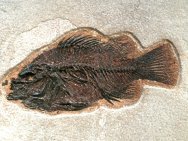|  Description:
This 50 million year old, Eocene-Era fossil fish comes from one
of the world's famous Laggerstatten, the Green River Formation in
Wyoming. A small portion of the fish fossils from Green River exhibits
such fine preservation. The significant extent of soft-tissue preservation
that makes the site famous is evident in this specimen. Description:
This 50 million year old, Eocene-Era fossil fish comes from one
of the world's famous Laggerstatten, the Green River Formation in
Wyoming. A small portion of the fish fossils from Green River exhibits
such fine preservation. The significant extent of soft-tissue preservation
that makes the site famous is evident in this specimen.
Genus
Priscacara is perhaps the most popular of the Green River fish fossils.
A member of the Family Priscacaridae, the name Priscacara means
"primitive head". Shaped rather like a sunfish, the genus
sports sturdy, protective dorsal and anal spines. Among the two
species, liops and serrata, serrata is uncommon. Liops is the smaller
species, never exceeding 150 mm, whereas serrata have been found
up to 375 mm. This fine specimen shows wonderful detail, including
the impression of the scales from the reverse side of the body cavity.
The dark body serves as a wonderful counterpoint to the light-colored
matrix. The genus went extinct at the end of the Miocene, and is
thought by some to be related to the modern-day Cichildae.
This
specimen comes from the so-called 18 inch layer noted for the fish
coming out complete on one side of the matirx and exquisite soft-tissue
preservation. The preservation here is particularly superb.
About
the Green River Formation: Class Actinopterygii, the ray-finned
bony fishes, comprise almost half of all known species of vertebrates,
some 20,000 extant species. There are numerous locations worldwide
that are noted for wondrous preservation of bony fishes, and the
Green River formation that covers some 25,000 square miles of SW
Wyoming, west Colorado and east Utah is one of the premier examples.
The formation is one of the largest lacustrine sedimentary accumulations
in the world, and spans the period from 40 to 50 million years ago
during the Eocene Epoch.
During
the Eocene, based on the fossil record, the region was sub-tropical
to temperate. Some 60 vertebrate taxa have been described from the
formation, including crocodiles, boa constrictors, and birds, as
well as abundant invertebrates and plants. The unusually excellent
preservation of the Green River fish fossils is usually attributed
to a combination of two factors: 1) a cold period during the Eocene
that would have caused dead fish to sink faster due to a less inflated
swim bladder; and 2) the great depth of the lakes and the consequent
anoxic conditions that would have often prevented scavengers from
disturbing the carcasses.
|